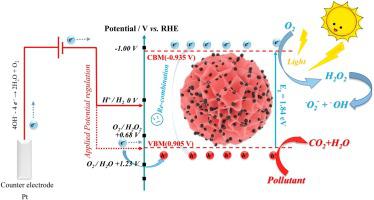Applied Catalysis B: Environment and Energy ( IF 20.2 ) Pub Date : 2020-06-17 , DOI: 10.1016/j.apcatb.2020.119249 Zhuohua Mo , Kun Wang , Hao Yang , Zuqiao Ou , Yexiang Tong , Tongwen Yu , Yi Wang , Panagiotis Tsiakaras , Shuqin Song

|
Herein, resulting from the heterojunction engineering, poly-terthiophene (pTTh) hybridized CuOxnanoparticles (abbreviated as CuOx@pTTh) are firstly synthesized and adopted as a promising photoelectrocatalyst for phenol degradation in wastewater. The resultant CuOx@pTTh manifests outstanding light-harvesting ability and remarkable capacity to separate photo-generated electron-hole pairs for phenol degradation in aqueous solution. X-ray photoelectron (XPS) characterizations and theoretical calculations further identify that there exists a strong electronic interaction between CuOx nanoparticles and pTTh, further enhancing the charge carriers transfer dynamics of the as-prepared catalysts. Electron spin resonance (ESR) spectroscopy and high performance liquid chromatography (HPLC) are applied to explore the active species and the degradation mechanism of photoelectrocatalyis (PEC) reactions. It is found that in PEC degradation of phenol the main active species are ·O2− and ·OH. Also, it can be concluded that phenol can eventually be step by step oxidized to CO2 and H2O through different pathways, according to the different detected intermediates.
中文翻译:

CuO x纳米粒子杂化的pTTh纳米花的异质结体系结构可有效地光电催化降解有机污染物
在本文中,由于异质结工程技术的原因,首先合成了聚对噻吩(pTTh)杂化的CuO x纳米颗粒(缩写为CuO x @pTTh),并被用作有希望的光催化降解废水中的苯酚的催化剂。所得的CuO x @pTTh表现出杰出的聚光能力和出色的分离光生电子-空穴对的能力,从而可降解水溶液中的苯酚。X射线光电子(XPS)表征和理论计算进一步确定了CuO x之间存在强电子相互作用纳米颗粒和pTTh,进一步增强了所制备催化剂的载流子转移动力学。电子自旋共振(ESR)光谱和高效液相色谱(HPLC)用于探讨光电催化(PEC)反应的活性种类和降解机理。据发现,在苯酚的PEC降解的主要活性物质是·O2 2 -和·OH。另外,也可以得出结论,酚最终可以逐步氧化成CO 2和H 2 o通过不同的途径,根据不同的检测到的中间体。











































 京公网安备 11010802027423号
京公网安备 11010802027423号